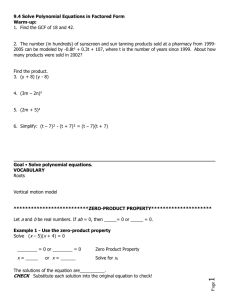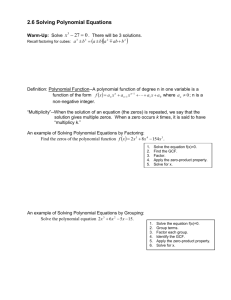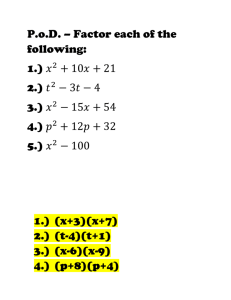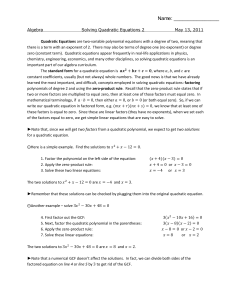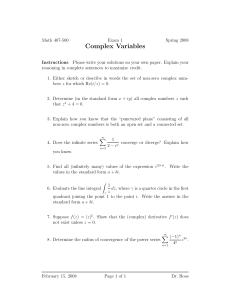STRONGLY ZERO-PRODUCT PRESERVING MAPS ON FUNCTIONAL
advertisement
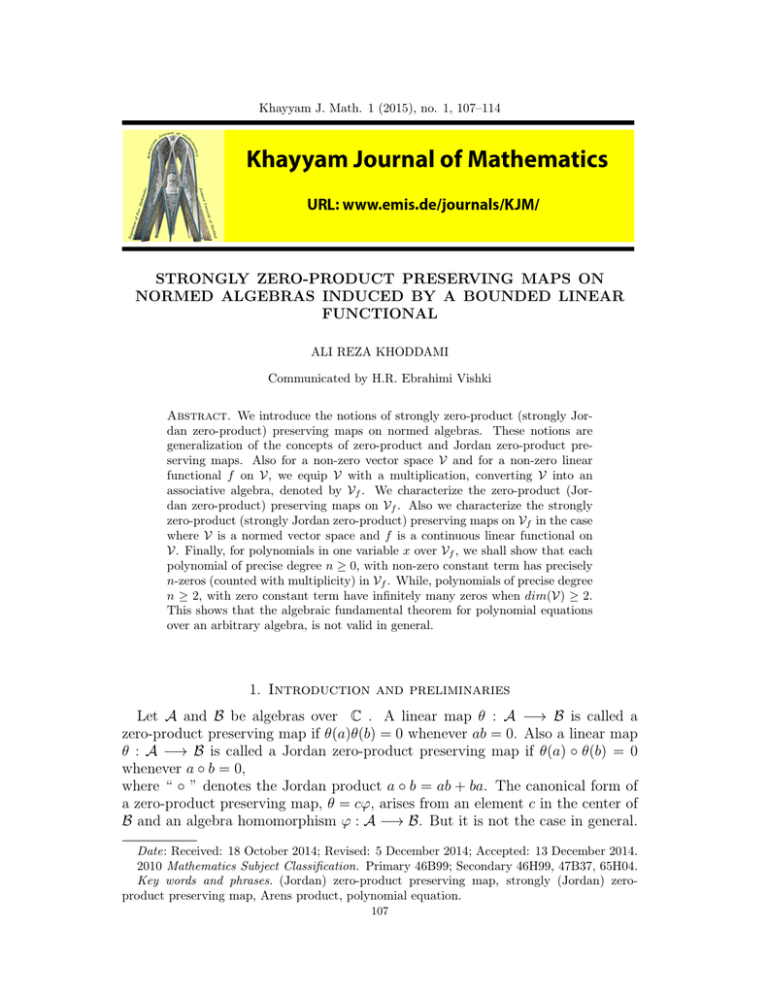
Khayyam J. Math. 1 (2015), no. 1, 107–114
STRONGLY ZERO-PRODUCT PRESERVING MAPS ON
NORMED ALGEBRAS INDUCED BY A BOUNDED LINEAR
FUNCTIONAL
ALI REZA KHODDAMI
Communicated by H.R. Ebrahimi Vishki
Abstract. We introduce the notions of strongly zero-product (strongly Jordan zero-product) preserving maps on normed algebras. These notions are
generalization of the concepts of zero-product and Jordan zero-product preserving maps. Also for a non-zero vector space V and for a non-zero linear
functional f on V, we equip V with a multiplication, converting V into an
associative algebra, denoted by Vf . We characterize the zero-product (Jordan zero-product) preserving maps on Vf . Also we characterize the strongly
zero-product (strongly Jordan zero-product) preserving maps on Vf in the case
where V is a normed vector space and f is a continuous linear functional on
V. Finally, for polynomials in one variable x over Vf , we shall show that each
polynomial of precise degree n ≥ 0, with non-zero constant term has precisely
n-zeros (counted with multiplicity) in Vf . While, polynomials of precise degree
n ≥ 2, with zero constant term have infinitely many zeros when dim(V) ≥ 2.
This shows that the algebraic fundamental theorem for polynomial equations
over an arbitrary algebra, is not valid in general.
1. Introduction and preliminaries
Let A and B be algebras over C . A linear map θ : A −→ B is called a
zero-product preserving map if θ(a)θ(b) = 0 whenever ab = 0. Also a linear map
θ : A −→ B is called a Jordan zero-product preserving map if θ(a) ◦ θ(b) = 0
whenever a ◦ b = 0,
where “ ◦ ” denotes the Jordan product a ◦ b = ab + ba. The canonical form of
a zero-product preserving map, θ = cϕ, arises from an element c in the center of
B and an algebra homomorphism ϕ : A −→ B. But it is not the case in general.
Date: Received: 18 October 2014; Revised: 5 December 2014; Accepted: 13 December 2014.
2010 Mathematics Subject Classification. Primary 46B99; Secondary 46H99, 47B37, 65H04.
Key words and phrases. (Jordan) zero-product preserving map, strongly (Jordan) zeroproduct preserving map, Arens product, polynomial equation.
107
108
A.R. KHODDAMI
For some good references in the field of zero-product (Jordan zero-product) preserving maps we refer the reader to [1] and [2].
Let A and B be two normed algebras over C. We shall say that a linear map
θ : A −→ B is a strongly zero-product preserving map if, for any two sequences
{an }n , {cn }n in A, θ(an )θ(cn ) −→ 0 whenever an cn −→ 0.
Also we shall say that θ is a strongly Jordan zero-product preserving map if, for
any two sequences {an }n , {cn }n in A, θ(an ) ◦ θ(cn ) −→ 0 whenever an ◦ cn −→ 0.
Let V be a non-zero vector space and let f ∈ V ∗ be a non-zero linear functional.
For each a, b ∈ V define a · b = f (a)b. One can simply verify that “ · ” converts
V into an associative algebra. We denote (V, ·) by Vf , that is an algebra. Note
that Vf is not unital in general. Indeed Vf is unital if and only if dimV = 1. Also
if dimV > 1 then Z(Vf ) = {0}, where Z(Vf ) is the algebra center of Vf . It is
obvious that Vf is not a commutative algebra. Indeed Vf is commutative if and
only if dimV = 1. Many basic properties of Vf such as Arens regularity, n−weak
amenability, minimal idempotents and ideal structure are investigated in [6] in
the case where V is a Banach space. Also the endomorphisms and automorphisms
of Vf are characterized in [5] when V is a vector space.
For an algebra A let A∗∗ be the second dual of A. We introduce the Arens products 4 and on the second dual A∗∗ . Let a, b ∈ A, f ∈ A∗ and m, n ∈ A∗∗ .
hf · a, bi = hf, abi, hn · f, ai = hn, f · ai and hm 4 n, f i = hm, n · f i. Similarly
hb, a · f i = hba, f i, ha, f · ni = ha · f, ni and hf, m ni = hf · m, ni. One can
simply verify that (A∗∗ , 4) and (A∗∗ , ) are associative algebras.
An algebra A is called Arens regular if the two Arens products coincide. One can
simply verify that Vf is Arens regular [6, proposition 2.1].
A polynomial P in one variable x over a ring R is defined to be a formal
S expression of the form P = an xn + an−1 xn−1 + ... + a1 x1 + a0 , where n ∈ N {0} and
coefficients a0 , a1 , ..., an are elements of R. A polynomial equation is an equation
such as, an xn + an−1 xn−1 + ... + a1 x1 + a0 = 0. In case of a polynomial equation,
the variable is considered an unknown and one seeks to find the possible values
that satisfies the equation. The solutions to the equation are called the roots
of the polynomial. By one of the most fundamental results in algebra, it is well
known that any polynomial of precise degree n, with coefficients in a given field
F , has precisely n zeros (when counted with multiplicity) in the algebraic closure
of F . This result fails for polynomials with coefficients in a finite dimensional
F −algebra [7]. In [4] Herstein proved that a polynomial of degree n, with coefficients in the center of an associative division algebra A, has either infinitely
many or at most n zeros in A. In [3] Gordon and Motzkin showed that a polynomial of degree n, with coefficients in an associative division algebra A which is
d−dimensional over its center, has either infinitely many or at most nd zeros in
A.
In this paper our purpose is to characterize zero-product (Jordan zero-product)
preserving maps on Vf . Also we characterize zero-product (Jordan zero-product)
preserving maps on (Vf )(2n) for all n ≥ 0, where (Vf )0 = Vf and (Vf )(2n) is the
2n−th dual of Vf that is an algebra equipped with one of the Arens products.
STRONGLY ZERO-PRODUCT PRESERVING MAPS
109
Also after introducing the notions of strongly zero-product (strongly Jordan zeroproduct) preserving maps, we characterize them on Vf in the case where V is a
normed vector space and f is a continuous linear functional on V. It is worthwhile
mentioning that the study of the zero-product (Jordan zero-product) preserving
maps on Vf is very interesting. Finally, we prove some interesting results concerning the number of roots of polynomial equations with coefficients in Vf .
The following examples are some different zero-product preserving maps on Vf
that are worthy of consideration.
(1) θ : Vf −→ Vf , θ(a) = g(a)c, where g is a linear functional on V and c is
a constant element of kerf .
(2) θ : Vf −→ Vf , θ(a) = f (a)b, where b is a constant element of Vf . (Note
that f is an algebra homomorphism from Vf onto C).
2. zero-product preserving maps on Vf
In this section we characterize the zero-product (Jordan zero-product) preserving maps on Vf . Also we emphasize that the zero-product preserving maps are
not homomorphisms multiplied by central elements, in general.
Theorem 2.1. Let V be a non-zero vector space and let 0 6= f ∈ V ∗ . Then a
linear map θ : Vf −→ Vf is a Jordan zero-product preserving map if and only if
θ(kerf ) ⊆ kerf .
Proof. In the case where θ ≡ 0 the result is obvious. Let θ be a non-zero Jordan
zero-product preserving map. Since for each a ∈ kerf , 2a2 = a2 + a2 = 0, so
2θ(a)2 = θ(a)θ(a) + θ(a)θ(a) = 0. It follows that f (θ(a)2 ) = f (θ(a))2 = 0,
which is equivalent to θ(a) ∈ kerf . So θ(kerf ) ⊆ kerf . For the converse let
θ(kerf ) ⊆ kerf and ab + ba = 0. So f (ab + ba) = f (a)f (b) + f (b)f (a) = 0. It
follows that 2f (a)f (b) = 0, which is equivalent to a ∈ kerf or b ∈ kerf . Without
loss of generality let a ∈ kerf . The equality 0 = ab + ba = f (a)b + f (b)a implies
that f(b)a=0 and so f (b)θ(a) = 0. It follows that b ∈ kerf or θ(a) = 0. Since
a ∈ kerf and θ(kerf ) ⊆ kerf so, θ(a)θ(b)+θ(b)θ(a) = f (θ(a))θ(b)+f (θ(b))θ(a) =
0 + 0 = 0. This shows that θ is a Jordan zero-product preserving map.
Theorem 2.2. Let V be a non-zero vector space and let 0 6= f ∈ V ∗ . Then
a linear map θ : Vf −→ Vf is a zero-product preserving map if and only if
θ(kerf ) ⊆ kerf .
Proof. In the case where θ ≡ 0 the result is obvious. Let θ be a non-zero zeroproduct preserving map. Let a ∈ kerf and b ∈ Vf such that θ(b) 6= 0. As ab = 0
so f (θ(a))θ(b) = θ(a)θ(b) = 0. It follows that f (θ(a)) = 0, which is equivalent to
θ(kerf ) ⊆ kerf . For the converse let θ(kerf ) ⊆ kerf and ab = 0. So f (a)b = 0,
which is equivalent to a ∈ kerf or b = 0. Since θ(kerf ) ⊆ kerf it follows that
f (θ(a)) = 0 or b = 0. So θ(a)θ(b) = f (θ(a))θ(b) = 0. This shows that θ is a
zero-product preserving map.
110
A.R. KHODDAMI
Corollary 2.3. Let V be a non-zero vector space and let 0 6= f ∈ V ∗ . Then a
linear map θ : Vf −→ Vf is a zero-product preserving map if and only if it is a
Jordan zero-product preserving map.
Corollary 2.4. Let V be a non-zero vector space and let 0 6= f ∈ V ∗ . Also
let the bijective linear map θ : Vf −→ Vf be a zero-product (Jordan zero-product)
preserving map. Then θ−1 is a zero-product (Jordan zero-product) preserving map
if and only if θ(kerf ) = kerf .
Remark 2.5. Note that in the case where dimV > 1 the linear map
θ : Vf −→ Vf , θ(a) = f (a)c, where c is a non-zero element of kerf is a zeroproduct (Jordan zero-product) preserving map but it is not a homomorphism
(Jordan homomorphism) multiplied by a central element.
Remark 2.6. Let V be a non-zero vector space and f ∈ V ∗ be a non-zero linear
functional. Also let fˆ be the canonical image of f in V (2n+1) , n ≥ 1. As by
[6, Proposition 2.1] (Vf )(2n) = (V (2n) )fˆ so by Theorems 2.1 and 2.2 a linear map
ϕ : (Vf )(2n) −→ (Vf )(2n) is a zero-product (Jordan zero-product) preserving map
if and only if fˆ ◦ ϕ = 0 on kerfˆ.
Corollary 2.7. Let V be a non-zero vector space, let 0 6= f ∈ V ∗ and let θ :
Vf −→ Vf be a non-zero linear map. Then the linear map θ∗∗ : (Vf )∗∗ −→ (Vf )∗∗
is a zero-product (Jordan zero-product) preserving map if and only if fˆ ◦ θ∗∗ = 0
on kerfˆ. (Note that fˆ is the canonical image of f in V ∗∗∗ ).
Corollary 2.8. Let V be a non-zero vector space and let 0 6= f ∈ V ∗ such that,
kerf = kerfˆ. Then a non-zero linear map θ : Vf −→ Vf is a zero-product (Jordan zero-product) preserving map if and only if the linear map
θ(2n) : (Vf )(2n) −→ (Vf )(2n) , n ≥ 0 is a zero-product (Jordan zero-product) preserving map.
Proof. As θ = θ(2n) |Vf , and f = fˆ|Vf the proof is obvious.
3. strongly zero-product preserving maps on Vf
Definition 3.1. Let A and B be normed algebras. We say that a linear map
θ : A −→ B is a strongly zero-product preserving map if, for any two sequences
{an }n , {cn }n in A, θ(an )θ(cn ) −→ 0 whenever an cn −→ 0.
Similarly a linear map θ : A −→ B is a strongly Jordan zero-product preserving
map if, for any two sequences {an }n , {cn }n in A, θ(an ) ◦ θ(cn ) −→ 0 whenever
an ◦ cn −→ 0.
Example 3.2.
(1) Let A, B be two normed algebras. Then every continuous
homomorphism θ : A −→ B is a strongly zero-product (strongly Jordan
zero-product) preserving map.
(2) Let V be a normed vector space with dimV > 1, and let 0 6= f be a
continuous linear functional on V. Then the linear map
θ : Vf −→ Vf , θ(a) = g(a)c,
STRONGLY ZERO-PRODUCT PRESERVING MAPS
111
where c is a non-zero constant element of kerf and g is a linear functional
on V, is a strongly zero-product (strongly Jordan zero-product) preserving
map. (Note that θ is not continuous in general).
It is obvious that each strongly zero-product (strongly Jordan zero-product)
preserving map is a zero-product (Jordan zero-product) preserving map. But
the converse is not valid in general. Indeed there are zero-product (Jordan zeroproduct) preserving maps that are not strongly zero-product (strongly Jordan
zero-product) preserving maps. To emphasize this fact it is useful to create an
illustrative example.
Example 3.3. Let V be a normed vector space with a countable basis β =
{e1 , e2 , e3 , ...} such that ken k = 1 for all n ≥ 1. Also let f ∈ V ∗ be a continuous
linear functional such that f (e1 ) = 1 and f (en ) = 0 for all n ≥ 2. So kerf =
span{e2 , e3 , e4 , ...}. Define θ : Vf −→ Vf such that θ(a) = f (a)e1 + ϕ(a), where
ϕ : Vf −→ kerf is a linear map such that ϕ(e1 ) = 0 and ϕ(en ) = 2n e2 for
all n ≥ 2. It is obvious that θ(kerf ) ⊆ kerf . So by Theorems 2.1 and 2.2, θ
is a Jordan zero-product (zero-product) preserving map. But we show that θ
is not a strongly zero-product (strongly Jordan zero-product) preserving map.
To this end let an = en1 and cn = en . So kan cn k = n1 ken k = n1 −→ 0. But
n
n
limn→∞ kθ(an )θ(cn )k = limn→∞ 2n ke2 k = limn→∞ 2n = ∞. This shows that θ is
not a strongly zero-product preserving map. A similar argument can be applied
to show that an ◦ cn −→ 0 but kθ(an ) ◦ θ(cn )k −→ ∞. So θ is not a strongly
Jordan zero-product preserving map.
Example 3.3 shows that it is worthwhile to characterize the strongly zeroproduct (strongly Jordan zero-product) preserving maps on Vf .
Theorem 3.4. Let V be a non-zero normed vector space and let 0 6= f be a
continuous linear functional on V. Then a linear map θ : Vf −→ Vf is a strongly
zero-product preserving map if and only if there exists a linear map
φ : Vf −→ kerf such that the following properties hold.
(1) φ(a) = θ(a) − f (a)θ(e) for some e ∈ f −1 ({1}).
(2) For any two sequences {an }n , {cn }n in Vf , f (θ(e))φ(an cn ) −→ 0
whenever
an cn −→ 0.
Proof. Let θ : Vf −→ Vf be a strongly zero-product preserving map. As θ is a
zero product preserving map it follows that θ(kerf ) ⊆ kerf . Since f 6= 0, let
e ∈ f −1 ({1}). For each a ∈ Vf , a − f (a)e ∈ kerf so there exists a function
φ : Vf −→ kerf such that θ(a − f (a)e) = φ(a), equivalently θ(a) − f (a)θ(e) =
φ(a). Clearly φ is linear because θ and f are linear. Now let {an }n , {cn }n be two
112
A.R. KHODDAMI
sequences such that an cn −→ 0. So θ(an )θ(cn ) −→ 0. It follows that,
(f (an )θ(e) + φ(an ))(f (cn )θ(e) + φ(cn ))
= f (an )f (θ(e))(f (cn )θ(e) + φ(cn ))
= f (an cn )f (θ(e))θ(e) + f (an )f (θ(e))φ(cn )
= f (an cn )f (θ(e))θ(e) + f (θ(e))φ(an cn ) −→ 0.
On the other hand f is continuous, so f (an cn )f (θ(e))θ(e) −→ 0. Hence
f (θ(e))φ(an cn ) = θ(an )θ(cn ) − f (an cn )f (θ(e))θ(e) −→ 0.
The converse is obvious.
Theorem 3.5. Let V be a non-zero normed vector space and let 0 =
6 f be a
continuous linear functional on V. Then a linear map θ : Vf −→ Vf is a strongly
Jordan zero-product preserving map if and only if there exists a linear map
φ : Vf −→ kerf such that the following properties hold.
(1) φ(a) = θ(a) − f (a)θ(e) for some e ∈ f −1 ({1}).
(2) For any two sequences {an }n , {cn }n in Vf , f (θ(e))φ(an ◦ cn ) −→ 0
whenever
an ◦ cn −→ 0.
Proof. An argument quite similar to the proof of Theorem 3.4 can be applied. Theorem 3.6. Let V be a non-zero normed vector space and let 0 6= f be a
continuous linear functional on V. Then a linear map θ : Vf −→ Vf is a strongly
zero-product preserving map if and only if one of the following conditions holds.
(1) f ◦ θ = 0
(2) θ(kerf ) ⊆ kerf and θ is continuous.
Proof. Let θ : Vf −→ Vf be a strongly zero product preserving map. As θ is a
zero-product preserving map, by Theorem 2.2, θ(kerf ) ⊆ kerf . If f ◦ θ 6= 0
then there exists a ∈ Vf such that f ◦ θ(a) 6= 0. For each sequence {cn }n
in Vf , satisfying cn −→ 0, since acn −→ 0 so θ(a)θ(cn ) −→ 0. Equivalently
f (θ(a))θ(cn ) −→ 0. Hence θ(cn ) −→ 0. So θ is continuous. For the converse, the
condition f ◦ θ = 0 clearly implies that θ is a strongly zero-product preserving
map. Let θ be continuous and θ(kerf ) ⊆ kerf . So there exists a linear map
φ : Vf −→ kerf such that φ(a) = θ(a) − f (a)θ(e), a ∈ Vf and e ∈ f −1 (1). As θ
and f are continuous so φ is continuous. Now let {an }n , {cn }n be two sequences
in Vf satisfying, an cn −→ 0. So
θ(an )θ(cn )
= (f (an )θ(e) + φ(an ))(f (cn )θ(e) + φ(cn ))
= f (an )f (θ(e))(f (cn )θ(e) + φ(cn ))
= f (an cn )f (θ(e))θ(e) + f (θ(e))φ(an cn ) −→ 0.
This shows that θ is a strongly zero-product preserving map.
STRONGLY ZERO-PRODUCT PRESERVING MAPS
113
Theorem 3.7. Let V be a non-zero normed vector space and let 0 6= f be a
continuous linear functional on V. Then a linear map θ : Vf −→ Vf is a strongly
Jordan zero-product preserving map if and only if one of the following conditions
holds.
(1) f ◦ θ = 0
(2) θ(kerf ) ⊆ kerf and θ is continuous.
Proof. An argument quite similar to the proof of Theorem 3.6 can be applied. Corollary 3.8. Let V be a non-zero normed vector space and let 0 6= f be a
continuous linear functional on V. Then a linear map θ : Vf −→ Vf is a strongly
zero-product preserving map if and only if it is a strongly Jordan zero-product
preserving map.
Proof. By Theorems 3.6 and 3.7 the result is obvious.
4. Polynomials with coefficients in Vf
From now on let V be a non-zero vector space over C and let f ∈ V ∗ be a nonzero linear functional on V. It is obvious that f is an algebraic homomorphism
on Vf , indeed for a, b ∈ Vf , f (ab) = f (f (a)b) = f (a)f (b). In this section we
characterize the form of a polynomial with coefficients in Vf . Also we show that
the algebraic fundamental theorem for polynomial equations over an arbitrary
algebra is not valid in general.
Proposition 4.1. Let V be a non-zero vector space, let f ∈ V ∗ be a non-zero
linear functional, and let P = an xn + an−1 xn−1 + ... + a1 x1 + a0 be a polynomial
over Vf . Then P = (f (an )f (x)n−1 + f (an−1 )f (x)n−2 + ... + f (a1 ))x + a0 .
Proof. Since ai xi = ai xi−1 x = f (ai xi−1 )x = f (ai )f (xi−1 )x = f (ai )f (x)i−1 x, i ≥ 1,
it follows that P = (f (an )f (x)n−1 + f (an−1 )f (x)n−2 + ... + f (a1 ))x + a0 .
It is clear that the polynomial P = an xn +an−1 xn−1 +...+a1 x1 +a0 is of precise
degree n ≥ 1 if and only if f (an ) 6= 0. If P = a0 and a0 6= 0 then P is of precise
degree n = 0.
Theorem 4.2. Let V be a non-zero vector space, let f ∈ V ∗ be a non-zero linear
functional, and let P = an xn + an−1 xn−1 + ... + a1 x1 + a0 be a polynomial over Vf
of precise degree n ≥ 0, with a0 6= 0. Then P has precisely n zeros in Vf .
Proof. Since the case n = 0 is trivial, we prove the theorem for n ≥ 1. Let
P = an xn + an−1 xn−1 + ... + a1 x1 + a0 = 0, that is equivalent to (f (an )f (x)n−1 +
f (an−1 )f (x)n−2 + ... + f (a1 ))x + a0 = 0. Since a0 6= 0 so (f (an )f (x)n−1 +
f (an−1 )f (x)n−2 + ... + f (a1 )) 6= 0. It follows that
−a0
x=
.
f (an )f (x)n−1 + f (an−1 )f (x)n−2 + ... + f (a1 )
On the other hand P (x) = 0 implies that f (P (x)) = 0. Equivalently,
f (an )f (x)n + f (an−1 )f (x)n−1 + ... + f (a1 )f (x) + f (a0 ) = 0. Let f (x) = z so
f (an )z n + f (an−1 )z n−1 + ... + f (a1 )z + f (a0 ) = 0 is a usual complex polynomial
114
A.R. KHODDAMI
equation of precise degree n ≥ 1 over C (note that since P is of precise degree
n, f (an ) 6= 0)). Let z1 , z2 , ..., zn be the solutions to the last equation. So for
i = 1, 2, ..., n,
−a0
xi =
n−1
f (an )zi + f (an−1 )zin−2 + ... + f (a1 )
are the solutions to the polynomial equation P = 0.
In contrast to the algebraic fundamental theorem we present the following
result.
Theorem 4.3. Let V be a non-zero vector space, let f ∈ V ∗ be a non-zero linear
functional, and let P = an xn + an−1 xn−1 + ... + a1 x1 be a polynomial over Vf of
precise degree n ≥ 2. Then P has infinitely many zeros whenever dim(V) ≥ 2.
Proof. Since P = (f (an )f (x)n−1 + f (an−1 )f (x)n−2 + ... + f (a1 ))x, so P = 0
implies x = 0 or f (an )f (x)n−1 + f (an−1 )f (x)n−2 + ... + f (a2 )f (x) + f (a1 ) = 0.
Let z = f (x) and let zi , i = 1, 2, ..., n − 1 be the solutions to the equation
f (an )z n−1 + f (an−1 )z n−2 + ... + f (a2 )z + f (a1 ) = 0. Since f is surjective so
zi = f (xi ), for some xi ∈ Vf , i = 1, 2, ..., n − 1. For each t ∈ kerf, zi =
Sn−1
(xi + kerf ) is the set of solution
f (xi ) = f (xi + t). It follows that X = i=1
n−1
n−2
to the equation f (an )f (x)
+ f (an−1 )f (x)
+ ... + f (a2 )f (x) + f (a1 ) = 0,
when x be considered as an unknown. Where xi + kerf = {xi +
St | t ∈ kerf }.
Since dim(kerf ) ≥ 1, so kerf is an uncountable set. Hence X {0} is the set
of solution to the equation P = 0, that is uncountable. This shows that P has
infinitely many zeros in Vf .
Remark 4.4. The previous theorem shows that the algebraic fundamental theorem
for polynomial equations over an arbitrary algebra is not valid in general.
Acknowledgement. The author would like to thank the referee for careful
reading of the paper and giving some useful suggestions.
References
1. M.A. Chebotar, W.-F. Ke, P.-H. Lee and N.-C. Wong, Mappings preserving zero products,
Studia Math. 155 (2003), no. 1, 77–94.
2. H. Ghahramani, Zero product determined triangular algebras, Linear Multilinear Algebra,
61 (2013), 741–757.
3. B. Gordon and T.S. Motzkin, On the zeros of polynomials over division rings, Trans. Amer.
Math. Soc. 116 (1965), 218–226.
4. I.N. Herstein, Conjugates in division rings, Proc. Amer. Math. Soc. 7 (1956), 1021–1023.
5. A.R. Khoddami and M. Hasani, Endomorphisms and automorphisms of certain semigroups,
J. Semigroup Theory Appl. to appear.
6. A.R. Khoddami and H.R. Ebrahimi Vishki, The higher duals of a Banach algebra induced
by a bounded linear functional, Bull. Math. Anal. Appl. 3 (2011), 118–122.
7. H. Röhrl, On the zeros of polynomials over arbitrary finite dimensional algebras,
Manuscripta Math. 25 (1978) 359–390.
Department of Pure Mathematics, University of Shahrood, P. O. Box 3619995161316, Shahrood, Iran.
E-mail address: khoddami.alireza@shahroodut.ac.ir
